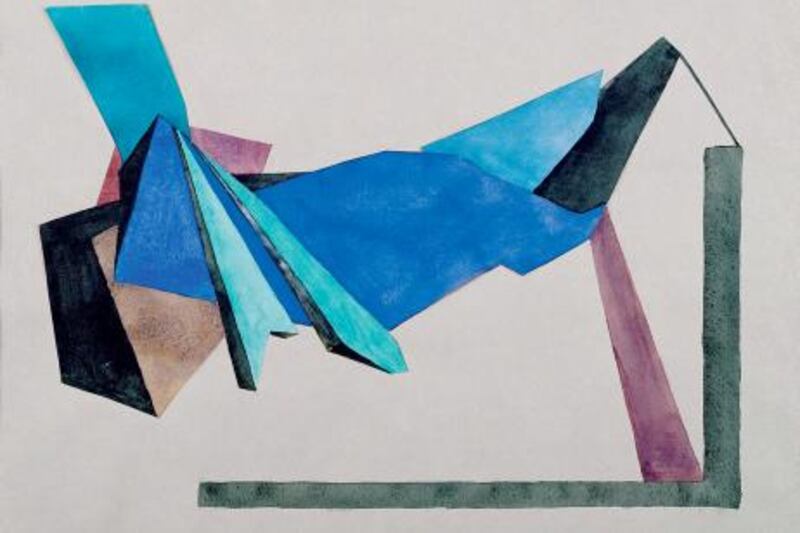British artists are often caught in the wake of the big "isms". Cubism sprung solidly from the continent. Surrealism was a keenly European affair. And although British artists did plug into such movements, many remain - rightly or wrongly - rather dim in the constellations of these monolithic movements.
The UK's very own "ism" in art, started just before the First World War, is often forgotten about entirely. Vorticism - however grand the name might be - has been sucked into a vortex of obscurity in accepted histories of this pivotal period.
But The Vorticists: A Manifesto for the Modern World, a charged overview of the movement currently showing at London's Tate Britain, might redress that.
The origins of Vorticism lie in the meeting of the poet Ezra Pound and the writer-painter Wyndham Lewis in London at the start of the 20th century. Both were hungry for a new visual language.
The great shake-up of Cubism was stampeding out of France while, at the same time, modernity roared into Europe's cities. This brought more cars, faster railways and - disturbing in hindsight - the devastating potential of mechanised warfare.
In Italy, this fed into Filipo Marinetti's Futurist Manifesto, a call to art to accept velocity as its new muse. The Futurists searched for how best to render an accelerated world. In Umberto Boccioni's canvases, for instance, horses abstract into flecks of pointed light, tearing through old cities like a sonic boom. But as Futurism evolved, its vision obscured: velocity came to mean power, and power was obtained through violence. Today, Futurism's proto-fascist leanings have earned it a questionable reputation.
When Lewis founded the Rebel Art Centre in 1914, a gathering place for artists disaffected with parochial Edwardian Britain, he'd been exposed to Futurism but wanted an alternative.
Chris Stephens, one of three curators working on the Tate show, suggests that the Vorticist project was a reaction to the way that modernism's potential was being explored by the group's peers.
"Lewis was also rebelling against the Bloomsbury Group, the likes of Roger Fry and Clive Bell, whose aesthetic was that art is only about its formal qualities. He was more interested in talking about life, and human existence in his work, and he set out a position that was radically abstract but engaged with subject matter in a way that the other modernists weren't."
With Lewis as leader, the Vorticists charted their own territory. Lewis's painting Workshop (circa 1914-15) is key to the Tate show and displays the angularity and geometry that came to define his work. He captured the discordance of the urban environment, seeing disharmonies in time, shape and colour as a wellspring of energy.
David Bomberg, though he never identified himself as a Vorticist, is also at the show's heart. His 1914 work Mud Bath sees the artist searching for a way to channel human forms into their most direct and essential representation. Amid a colour field of pale red, bathers with limbs and bodies resembling shafts of light seem to quiver with energy. It's an image that remains exhilarating even today.
"The vortex is the point of maximum energy," writes Pound in the first issue of BLAST, the group's journal of fragmented poetics and black-and-white photographs of their work, published in June 1914. A startling piece of graphic design for its time, BLAST's second and final edition would publish early work by the poet TS Eliot, who was then relatively unknown.
The Vorticists also presents work by a number of female artists. Pieces by Jessica Dismorr, Dorothy Shakespear and several only recently discovered pieces by Helen Saunders are included, some of which present the most divergent work in the group. Shakespear created an energetic, bright blue collage that zigzags across the canvas. "Forms tend to interlock in the Vorticists' paintings, but hers has a tension," says Stephens. "It's held between two points."
Yet it's fitting that a movement driven by the idea of energy would have such an energetic rise and fall.
"Vorticism eked itself out, more or less, in the course of a year," says Stephens.
It was named as a movement in the late summer of 1914 by Pound. The group's only English exhibition took place in 1915, in London's Goulin Gallery, and by then most of the painters were holed up in Europe's trenches of the Great War. Henri Gaudier-Brzeska, a French sculptor whose witty, playful sculptures feature in The Vorticists, had already been killed in combat.
Vorticism's brief existence is partly to blame for why it is so often overlooked. And although the artists of the movement were fairly prolific, much of their output has since been lost.
There's also a sweeping association with Futurism, and its fascistic leanings, which doesn't work in favour of the group's legacy. Though Pound would later ally himself with Mussolini and Lewis would write a glowing report of Hitler in the early 1930s, Stephens is resistant to the idea of germinating fascist ideas in the Vorticist project.
The curator is keen to point out, instead, the group's radicalism. Here is a movement distinct from both Cubism and Futurism. "Stylistically, they were more extreme than the Futurists," says Stephens. "Meanwhile, Picasso and Braque were still abstracting life into Cubism.
"Aside from Malevich in Russia, who was painting simple black squares, the Vorticists were then about as extreme as abstract painting went."
The Vorticists: A Manifesto for the Modern World is on at London's Tate Britain until September 4.





